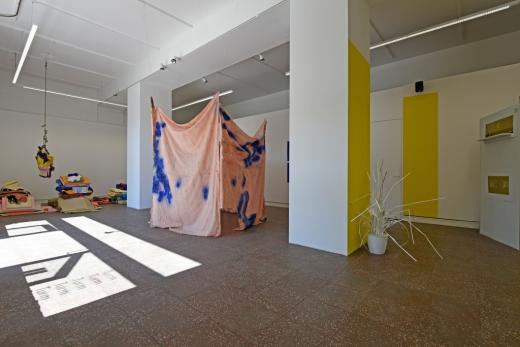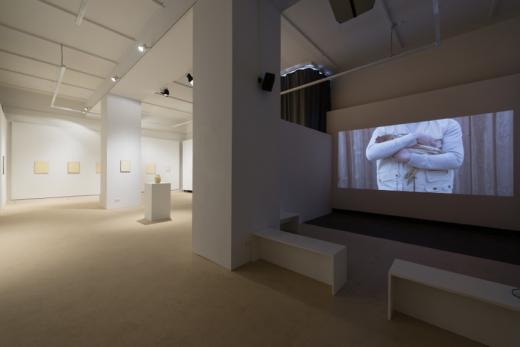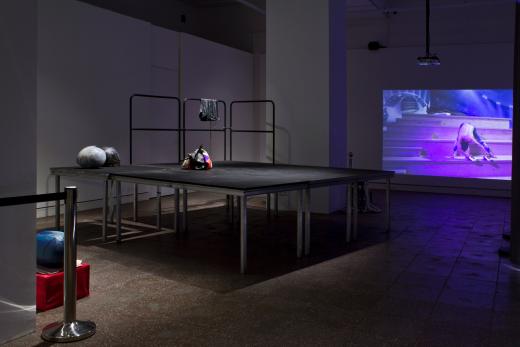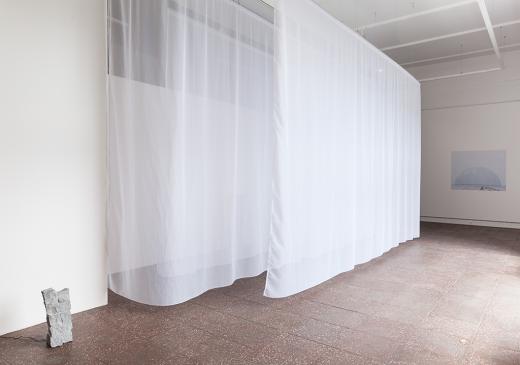Have you met... Galerie im Turm
Have you met... Galerie im Turm

A fresh curatorial approach and new artistic positions might give you an impression of Galerie im Turm as a fairly recent member of Berlin's art scene. The gallery is, in fact, more than 50 years old, and has existed with the current program format since 2011. Today, as a communal gallery of the district Friedrichshain-Kreuzberg, it shows contemporary art with the focus on solo shows of Berlin-based artists.
Since January 2016, Celina Basra and Melina Gerstemann have been responsible for the gallery's program. We spoke with Celina about the projects realised in the gallery during their curatorial mandate, which will end with the closing of Galerie im Turm's next exhibition, "Kaufen Sie Uns" (September 15 – October 29, 2017).
Could you briefly introduce us to the history of Galerie im Turm? How long has the space been around, what was it all about in the beginning, and what remains of the original concept?
Galerie im Turm was founded in 1965 as an exhibition space of the VBKD (Verband Bildender Künstler der DDR). It is located on the ground floor of the north tower of Frankfurter Tor, designed by Henselmann. Since 1990, Galerie im Turm has been a communal gallery of the district of Friedrichshain-Kreuzberg. Its main focus lies on solo exhibitions of young Berlin artists, presenting 6-7 exhibitions each year. Since 2011, young curators have been responsible for the curation of the space as part of a trainee program, working together with Stéphane Bauer, director of Kunstraum Kreuzberg/Bethanien.
Looking back on the last two years of running the program of Galerie im Turm – which curatorial ideas and projects were you able to realise here?
Looking back at the origins of the gallery and exploring the space itself, as well as the surroundings, were an integral starting point for our curatorial approach. Producing site-specific and process-based works meant thinking quickly and flexibly, as well as working together closely with the artists – and with Melina Gerstemann, if we curated the project together – in a constant, energetic ping-pong.
Besides curating our own projects, we were able to realize three experimental curatorial formats together: the exhibition „Turm Turm Turm“ in the summer of 2016, which unfolded in three chapters, as well as „Work Play Display“ at the beginning of 2017 – moving our office and thinking space with all its enthusiasm and frustration into Galerie im Turm. And finally, „Kaufen Sie Uns“, our goodbye show, opening on September 14 during this year's Berlin Art Week.

Stephanie Keitz, J&K & Lola Göller – "TURM TURM TURM – DIE GALERIE IN DREI KAPITELN" @ Galerie im Turm
How did you develop the program and choose the artists for the shows you've curated here?
We entered Galerie im Turm with its long history as a blank slate – for us, it was an unknown territory. Bit by bit, and together with the artists, we attempted to make this space our own. We produced a series of context-conscious exhibitions in our first year: exploring the gallery and its history in research, site-specific installations and collaborations with local residents. In our second year we focused on the dynamic roles of working in the arts, looking at various aspects of what it means to work in a gallery – to work and represent work simultaneously, acting in high visibility at all times.
What were the challenges and what were the advantages of working in this space?
Challenges: the restrictions of budget, time, space, expectation, and institution, as well as questioning our roles as curators.
Being able to work as independently as we did within the framework of an institution is quite rare. Curating a cohesive, relevant, and complex two-year program presented a challenge and a very valuable experience. Galerie im Turm itself was a great and unusual space to work with.

Moritz Frei – "COSMIC LATTE" @ Galerie im Turm
Could you pick a show organised here that was a personal highlight?
All of our projects brought specific aspects into our curatorial reflections. Melina curated "Cosmic Latte", an exhibition with Moritz Frei, for which the artist found elderly inhabitants in the surroundings of the gallery to paint and talk with him. In an installation encompassing the whole space, including a film, paintings and other objects, one could find his artistic play with associations on the space itself, as well as the current situation of Frankfurter Tor, Berlin, work, and art.
The experience of working together with Stefan Panhans and Andrea Winkler for „A Gallerina’s Dream (Arbeitstitel)“ in March/April 2017 will definitely stay with me. The initial impulses were current realities of work, art, and exhibition production. A gallery as a work space is representative and public. We act on a stage, are hosts, show masters and directors. Space, time, and financial resources determine the actions of inviting and showing, attention, exclusion, and control. How do we want to work and represent work – particularly in a gallery space? Stefan Panhans and Andrea Winkler worked with the central image of the gallery as a stage in a choreographed setting of Winklers' objects and Panhans' video work „Freeroam À Rebours, Mod#I.1“.

Stefan Panhans & Andrea Winkler – "A GALLERINA'S DREAM (ARBEITSTITEL)" @ Galerie im Turm
What are the topics you're mainly concerned with as curators?
Right now I am interested in how space and time of work and play, control and leisure function. Departing from „A Gallerina's Dream“ and the current exhibition „Park“, my research on the issue is ongoing. I am currently reading „ParK“ by Bruce Bégout; a dystopian vision of a theme park of the future. Also, I would like to see the ability to fail represented in the exhibition space: imperfection, trial and error, unrealised projects, frustration, interruptions, fragments, grains, bits, and particles.
The topics I am concerned with are linked to Melina´s interest to include the social sphere and situations and phaenomena of everyday life into her projects – and to enable thinking about the autonomy of art with respect to its position in societal contexts on a humorous level.
Could you tell us something about the exhibition currently on display at Galerie im Turm?
In times of radical convergence of work and play, the current exhibition „PARK“ looks at spaces designed for leisure – in spatial strategies of sound, scent, and sculpture, as well as photography and film. Lola Göller, Lilli Kuschel, and Sara-Lena Maierhofer are three of the seven artists participating. „PARK“ is a theme park, a zoo, a playground, the idea of an island, a concept store, holiday park, and also, a kind of kindergarten. Spreepark is a PARK, Tropical Islands is a PARK, Tate Turbine Hall is a PARK, Holzmarkt 25 wants to be a PARK, too. Other PARKS are: Neverland, Tinder, Disneyland, and Dismaland. It’s on view until September 3.

"PARK", with Lola Göller, Kathrin Günter, Lilli Kuschel, Klara Ravat, Randi Renate & Kay Walkowiak @ Galerie im Turm
What's coming up next?
Our last project, „Kaufen Sie Uns“, looks at the application process and makes its diverse formal, social, and emotional aspects visible in space – oscillating between self-image and the perception of others. Instead of a conventional opening, there will be a live application training on September 14, starting at 5 pm. You are warmly invited!
Who will be the next to take over Galerie im Turm's program?
Lena Reisner and Sylvia Sadzinski. Their program will start in 2018.
Any personal future projects you would like to share with us?
I will continue the thought process on the Park concept. I would love to realize a second edition of the exhibition, focusing on digital Park spaces.
Stefan Panhans, Andrea Winkler, Lisa-Marie Janke and I worked together on the role of the gallerina for a short Gallerina video in March. The Gallerina's Dream Team is currently planning to produce a second video together – it might become a series.
* * * * *
GALERIE IM TURM
Frankfurter Tor 1, 10243 Berlin
galerie-im-turm.net
Current exhibition:
"PARK"
Ongoing until 03.09.2017
More info
Coming up:
"KAUFEN SIE UNS"
15.09 - 29.10.2017
More info